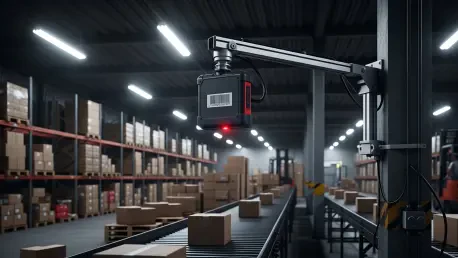In a world where seconds count, warehouses across industries are racing to meet ever-increasing demands. As e-commerce expands, the pressure mounts on logistics, manufacturing, and retail sectors to handle larger order volumes and quicker return cycles. Amidst the hustle to enhance productivity and reduce errors, one question arises: Could the key to unlocking ultimate warehouse efficiency lie in automation?
The Drive Toward Automation in Warehousing
The explosion of e-commerce has set off a domino effect, leading to higher expectations for fast delivery and easy returns. Companies face intense pressure to maintain accuracy and efficiency while keeping costs down. The rising demand for precise order fulfillment highlights the necessity to minimize human error, pushing firms to seek technological solutions to stay competitive.
Employing automation tools like fixed industrial scanners provides a strategic answer to these challenges. By streamlining processes, these devices not only help in achieving zero-error operations but also lead to substantial time and cost savings. Companies now emphasize integrating innovative technology to adapt quickly to dynamic market conditions.
Transformative Role of Fixed Industrial Scanners
Fixed industrial scanners, or automated barcode readers, present a new era of streamlined warehouse operations. Positioned strategically, they eliminate the need for manual scanning, tagging items like pallets and packages seamlessly as they move through production lines. This automation revolutionizes inventory management by delivering real-time data, sharpening decision-making processes.
Industries such as logistics and retail are witnessing transformative benefits from these technologies. Utilizing machine vision, fixed scanners offer enhanced capabilities like defect detection and optical character recognition, ensuring high standards in quality control. As a result, businesses can remain competitive while reallocating human resources to tasks that demand critical thinking and creativity.
Insights on Scanner Adoption
Industry experts extol the virtues of integrating fixed industrial scanners into warehouse systems. Through collaborations with companies like Zebra Technologies, businesses can access tailored solutions that meet their specific needs, demonstrating remarkable productivity boosts. Case studies illustrate firms experiencing dramatic improvements, pointing to automated scanning as a pivotal factor behind increased efficiency.
For example, companies that have partnered with Renovotec report significant operational enhancements due to streamlined scanning processes. The successful implementation of such solutions illustrates the immense potential for businesses willing to embrace this technological shift and transform their operational frameworks.
Getting Started with Implementation
Implementing fixed industrial scanners begins with selecting the right technology tailored to business goals. Training staff ensures they understand new systems, maximizing the potential of these tools. Strategic positioning of scanners in warehouse operations is crucial; poor placement can undermine efficiency objectives aimed at achieving gains.
Balancing initial costs with long-term savings becomes key as businesses weigh automation’s upfront investment against enduring benefits. Partnering with technology specialists aids in devising solutions to meet unique business challenges. This collaborative approach often delivers feasible proofs of concept, paving the way for successful technology adoptions.
Paving the Way Forward
In the quest for heightened efficiency, warehouses increasingly shifted towards automation, capitalizing on fixed industrial scanners’ capabilities. This evolution responded to escalating e-commerce demands and shifting customer expectations. By unlocking remarkable operational potential, businesses modernized their strategies and processes, staying competitive. Undertaking this transformation involved strategic planning and technological expertise, reaping benefits while navigating new challenges.









